
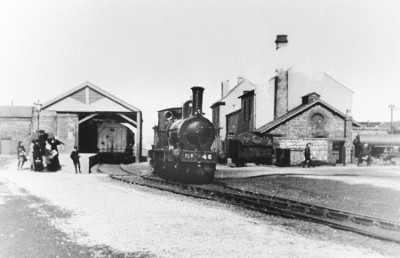
Saturday 16th. June 2018 – Furness Railway Piel Branch.
This outing, which was led by CRA Member Howard Quayle, explored the remains of the Furness Railway’s Piel branch, which opened on 24 August 1846 as part of the original main line, and which closed on 6 July 1936.
Walking distance from a point near Salthouse Junction to Roa Island, via the causeway from Rampside, was approximately 3 miles, with most of this being footpath or pavement (across the causeway). Adjacent to the listed Roa Island Hotel (no longer in use as licensed premises), the remains of the approach to Piel Pier were inspected.
Rampside station (also known as “Concle” station for a short period in 1868-1869) was passed en route, although what remains has now been incorporated into a private house. The curious name “Concle” is derived from the adjacent inn.

Saturday June 17th. 2017 – Langwathby and Long Meg, Armathwaite and Howe & Co sidings area of the Settle and Carlisle Railway.
As a result of illness, injury and family issues, 6 members (instead of the expected 10) met at Little Salkeld and spent a glorious sunny (and hot) morning exploring the remains of the Gypsum mining operation and associated rail connections at Long Meg. These remains included a number of main line sleepers, chairs and clearly visible trackbed, and narrow gauge trackwork and some wagons. The group then moved to Armathwaite where John Johnson, on behalf of the FoSCL, made us very welcome in the restored signal box and explained its history and the artefacts there, many of which originated in that box. Following lunch, the party continued to Cocklakes where the tramway from the gypsum processing works to the Howe & Co. Sidings crossed the road – with track still visible, embedded in the tarmac. The exchange siding area was viewed, as was the Signal Box, now the S&C Fringe box to the Carlisle Power Box.
Party examines the remains of the level crossing on the Cocklakes tramway to Howe & Co. siding.
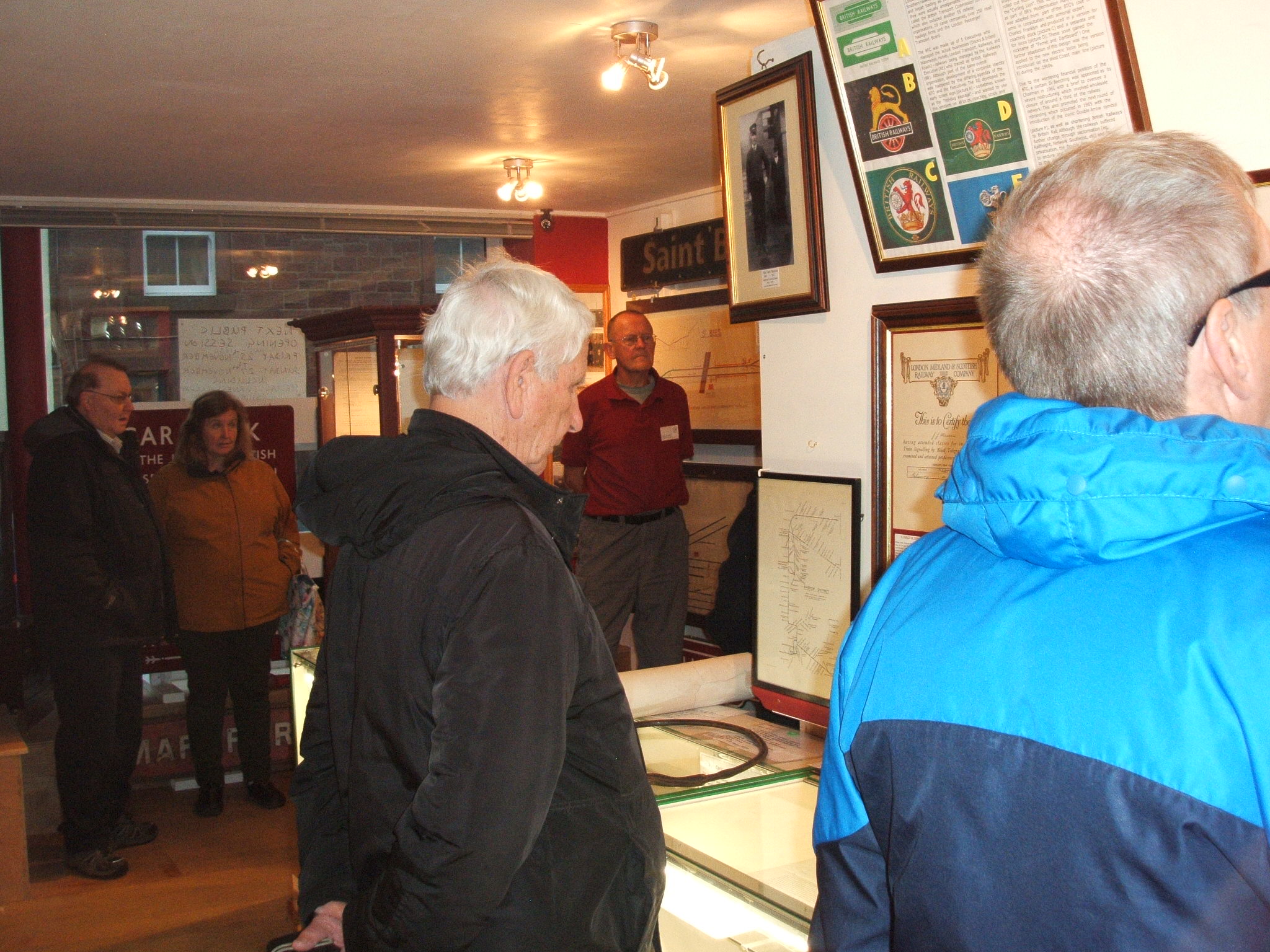
Sunday November 13th. 2016 - West Cumberland Railway Museum and Swansong trip along the Beckermet to Sellafield track bed of the WC&ER.
This completed the visits to the track of the WC&ER which started in March 2011 visiting the Moor Row and Cleator areas, March 2013 visiting the Bigrigg area and November 2014 visiting Egremont and the area south of there.
The trip visited the trackbed from Beckermet to Sellafield, noting the start of work reinstating the stub of the branch at the Sellafield end. This trackbed will be within the boundaries of the Moorside project, and the Sellafield end will be reinstated to provide rail access into the site, hence visiting it while that is still possible.
Several relics were still visible, including the 8 ½ mile post (from Moor Row) and the bridges which all seemed to have been built for double track, although the line and its embankments was only ever single track.
Following lunch, the trip then visited the recently opened West Cumberland Railway Museum in St Bees which houses a large and fascinating collection of Cumbrian railway artefacts.

Saturday June 18th. 2016 – Kirkby Stephen East, Stainmore and Belah Viaduct site.
This trip started with a visit to Kirkby Stephen East station, the base of The Stainmore Railway Company, where we were shown around the site and heard of the plans which are in place to develop the site and restore various buildings, locomotives and items of rolling stock.
From there, the trip was led by Mark Keefe to Stainmore Summit and back to the site of Belah Viaduct, passing Bleathgill Cutting and the remains of Mousegill viaduct en-route. The abutments, footings of the last set of piers to be demolished and various other relics of Belah Viaduct were still clearly visible, as was the tranquil setting for such a masterpiece of civil engineering.
The challenges in constructing and operating this line were readily appreciated, having viewed these locations.
Belah Viaduct remains, looking from the Barras end abutments to the Kirkby Stephen end abutments.
Sunday March 20th. 2016 - Langwathby and Long Meg, Armathwaite and Howe & Co sidings area of the Settle and Carlisle Railway.
This trip had to be cancelled due to circumstances beyond our control, following Storm Desmond. Instructions were:
"This trip will meet at Little Salkeld green (post code CA10 1NN) at 10.30 am. We will walk into and around the Long Meg mines and narrow gauge tramway areas. After this lunch may be taken at The Watermill in Little Salkeld if members wish (to be confirmed).
After lunch, we will move to Armathwaite where we will visit the signalbox, now owned by FoSCL and no longer operational. We continue to the vicinity of Cotehill where we will explore the remains of the sidings and tramways associated with the various works at the Howe and Co sidings.
The trip will be led by one of our members, James Wood, a tour leader with the FoSCL, aided by Graham Brooks and Ken Harper.
We will need to make a donation for visits to the Armathwaite signalbox, so trippers are requested to bring some change. Parking at both Little Salkeld and Cotehill is limited, so car sharing is encouraged.
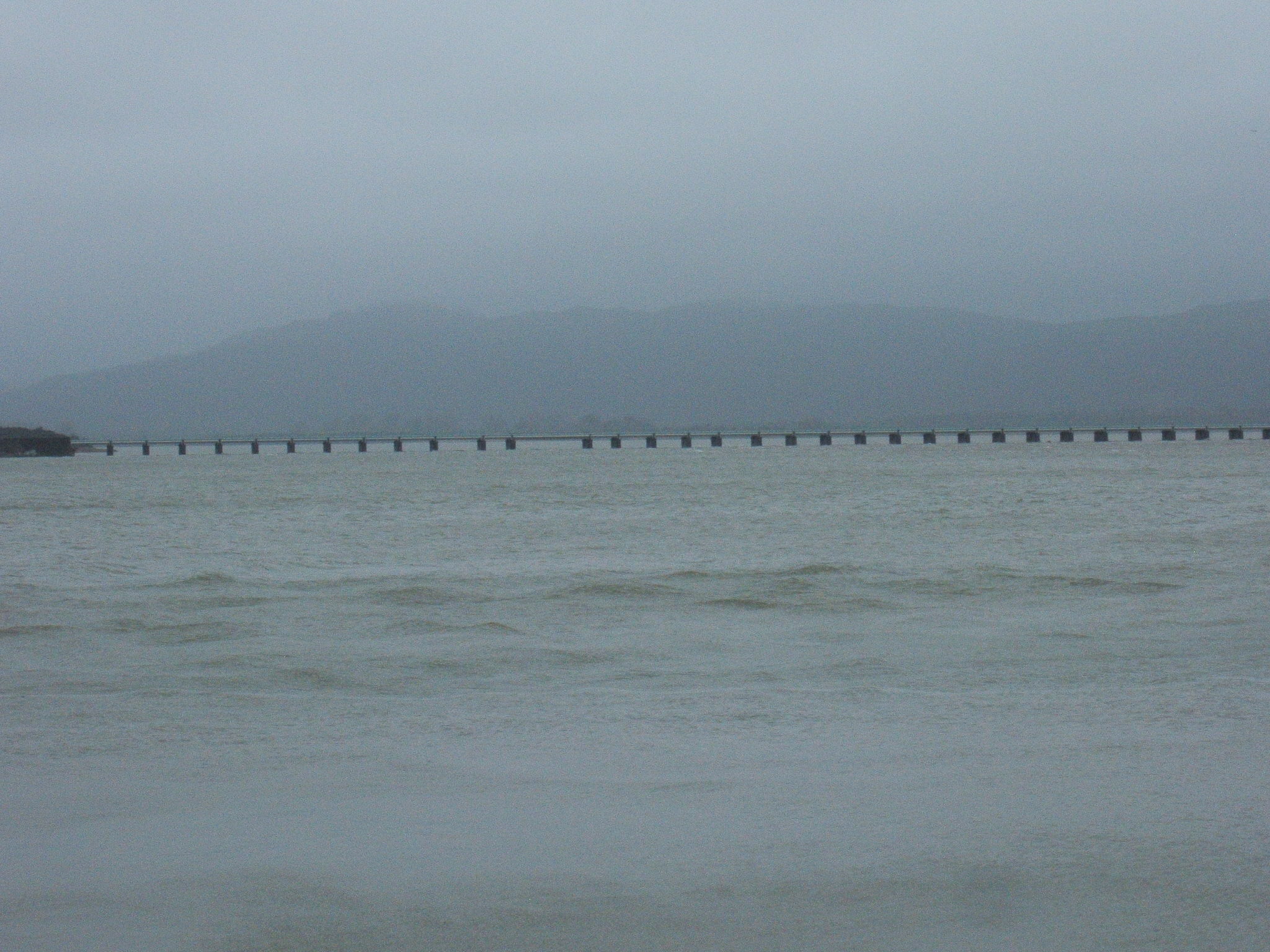
Sunday November 15th. 2015; Grange and Ulverston areas.
The trip was led by our Chairman, Les Gilpin, author of "The Ulverstone and Lancaster Railway" published by the CRA.
A group of six braved weather warnings and enjoyed a day exploring the Ulverston Canal sidings, Glascow tramway, sections of the Bardsea branch and sliding bridge over the canal, North Lonsdale Iron & Steel company quarry sidings, Plumpton Junction and initial parts of the Lakeside Branch.
Some sections were still clearly visible, with some unexpected relics, while others had totally disappeared. The sliding bridge, which still exists even though it is many years since it moved, provoked a considerable amount of discussion over its method of working.
The party were surprised by the extent of railway developement around such a relatively small location.
Levens viaduct showing location of former sliding span.
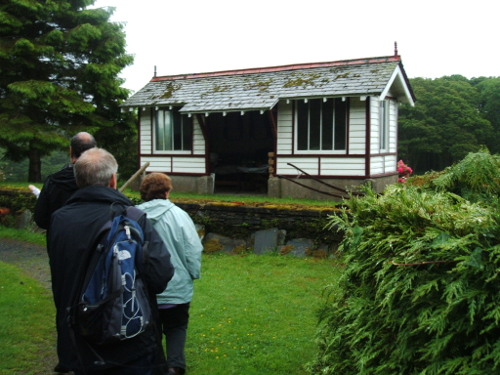
Saturday June 20th. 2015; The Coniston Branch from Foxfield up to Coniston.
Twenty one trippers were met at Foxfield station by an ex-Cumberland Motor Services Bristol MW bus no. 231, AAO 34B which took us to Coniston, allowing the party to return along the line, calling in at various points of interest along the route.
The journey, via the Bush Hall crossing keeper's house at Foxfield, was challenging for Neil and his brother Roger who manfully drove the bus. We were reminded of the sheer hard work involved in taking buses without power steering, servo brakes or full synchromesh gearboxes along such narrow, winding and steep roads.
Little remains at Coniston itself, apart from the goods yard, now a car park, but once outside the village limits, numerous traces of the trackbed still remain, including the station and platform at Torver (now a holiday cottage), the signalman and platelayer’s cottages and station facilities at Woodend and the station buildings at Broughton.
This was a very interesting trip, very ably led by Howard Quayle, with reminiscences added by various members.
Woodend Up platform and waiting shelter.

Sunday March 22nd. 2015; Railways and tramways of Flimby Great Wood.
A group of eight eventually made this walk which was led by Mike Faulkner who has been involved in surveying these remains.
This is an area with a history of mining, tramways and railways going back 200 years or more. The group saw the remains of a rope worked tramway incline which led from the older Seatonmoor pits down to Flimby and a rope worked railway incline from Robin Hood pit down to Risehow colliery at Flimby. This latter continued on, worked by horse power, to Broughton Moor fire brick works and Bertha Pit.
At Robin Hood pit, parts of the incline winding drum structure and updraft shaft chimney were visible, and some members also viewed the old iron smelting furnace below the pit bank.
This was a fascinating walk, made particularly interesting by the extensive knowledge which Mike had amassed over the years.
Remains of the rope hauled railway winding house at Robin Hood Pit.

Sunday November 9th. 2014; Railways South of Egremont.
A party of seven gathered at the car park at Longlands Lake and viewed the remains in the Longlands area, including the world's oldest Spade Forge and Ehen Hall, the home of the Lindow family and then explored those leading towards Clintz Quarry followed by the Florence Mine area. These included the Ehen Valley branch, the Gillfoot branch and the exchange sidings and branch for the no. 1 Florence Pit.
After this, we moved on to the Beckermet Mines area including Winscales Moor and Haile Moor Mines. We did not walk the track bed from Sellafield to Beckermet as this is now largely devoid of railway interest, and is a very simple walk; it was also raining very heavily by this stage!
Site of the exchange sidings to Florence Mine no. 1 Pit (between the trees), with the main line continuing to Egremont skirting the trees on the right. The line to the pit ran from the sidings to the location where the photograph was taken from.

Saturday June 7th. 2014; Wetheral, Haltwhistle and South Tynedale Railway.
A group of three defied the predicted heavy rain and met at 10am at the car park of Corby Bridge Inn, Great Corby. They visited the Wetheral viaduct and station, including the ruins of the Earl of Carlisle's private waiting room.
Progressing on towards Corby Viaduct allowed a view of the viaduct from rail height, but access at ground level proved impossible. The group then proceeded to Haltwhistle where they viewed the extant station facilities, water tower and crane and then visited the old NER signal box. The group then walked along the Alston branch to view the Alston Arches.
The day concluded with a visit to the South Tyndale Railway (recent recipients of a Heritage Lottery Grant). The visit included a trip on the railway.
Corby Bridge (Wetheral Viaduct) built in 1831 to carry the Newcastle and Carlisle line over the River Eden seen from Wetheral Mill in June 2014.
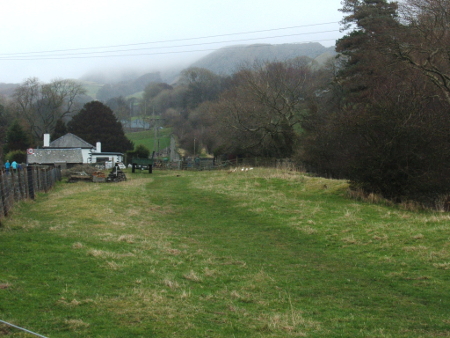
Sunday March 16th. 2014; Kirkby Moor Incline and Dunnerholme Siding.
Some 15 trippers gathered at Kirkby Station to follow the route of the connection to the foot of the incline leading up to the slate workings above Kirkby. The walk was led by Peter Holmes, assisted by Johnathan Wignall, who used to work at the quarries.
The remains of the exchange sidings and facilities and the incline were inspected. The trip was told about old parts of the quarry which contained some enigmatic stone blocks which could be parts of a former c1820) stone wagon way leading from the then quarry, to one of the spoil heaps.
The second part of the trip was led by Graham Robinson, and visited the site of the Dunnerholme sidings, where the track of the siding was still discernable many years after lifting. The remains of several lime kilns (used to produce agricultural lime) were also seen.
Standard gauge trackbed at Kirkby-in-Furness, and the site of the loading dock and weigh house at the foot of the narrow gauge incline leading up to Kirkby Moor Slate quarries.
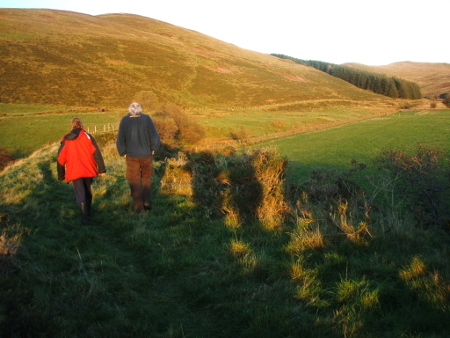
Sunday November 10th. 2013; Broughton Moor Armaments depot railways.
Twenty seven people gathered in brilliant sunshine to view the railway relics at Broughton Moor ex-RNAD, facilitated by Nigel Catterson of the Derwent Forest Development Conservation and led by Philip Tuer.
The visit viewed where the Buckhill Branch entered the site and progressed to the transhipment sheds where armaments were transferred onto the internal narrow gauge line for movement to and from storage sheds and laboratories for maintenance.
The tour then continued to the area of the Pit Bank at the former Buckhill Colliery, where the offices, facilities and workshops were located; all now demolished. The site of the mixed gauge locomotive sheds were viewed, although all that now remains is the concrete slab with tracks inset and the old colliery coal chute walls. The tour returned to the start via the laboratory area.
In the afternoon, nine members continued on via the bridge over the old Ullock to Distington branch to the site of the Lamplugh tramway and then to Salterhall quarry where the trackbeds to that quarry, Stockhowhall Quarry and the Rowrah and Kelton Fell railway converged, finding the remains of the junction signal box, loco shed and natural tunnel with a quarry branch tunnelled under the R&KF line.
Finally the trip visited the final section of the R&KF line, again finding the remains of the loco shed and offices and workshops long buried in the woods.
Rowrah and Kelton Fell railway, the final stretch of trackbed with sleeper indentations still visible, heading towards Kelton Fell.
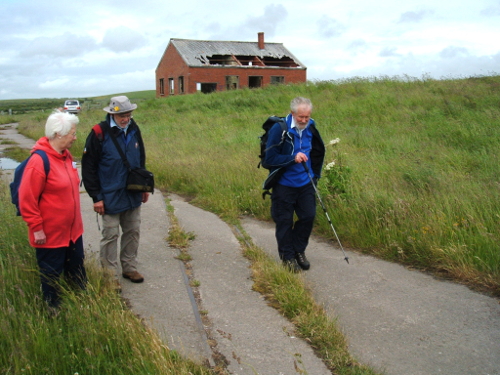
Sunday June 22nd. 2013; Workington to Parton.
Eight CRA members joined a 14 strong party composed of members of the CIHS and Railway Ramblers to view some of the lines south of Workington.
It started by viewing the station precinct and signal boxes before following the line south with certain diversions to view other formations of interest as far as Harrington. After lunch the majority of the Lowca Light Railway was followed to the village of the same name before a descent was made to Parton where this walk concluded.
Having seen the remains of the harbour bridge, demolished as a result of damage in the 2009 flood, the trip covered the remains of the Derwent and Moss Bay Iron & Steel Works lines, the Harrington Harbour line, Wilkinson's Wagon Works, Harrington Junction to Rosehill Junction and Lowca Light Railway lines.
It passed through Church Road and Archer Street stations (two of Harrington's five), Copperas Hill Halt, Micklam Fireclay works, Harrington no.10 Colliery site and passed the site of the Fletcher Jennings locomotive works, now a sewerage works!
Narrow Gauge tramway and structures at the Micklam fireclay workings.
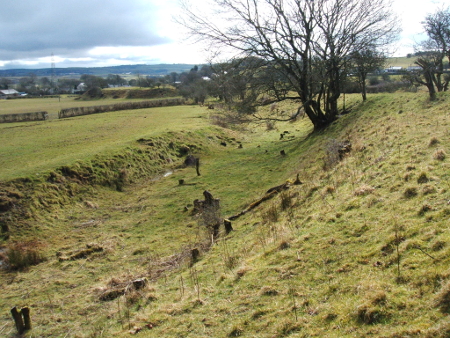
Sunday March 17th. 2013; In Search of the Bigrigg Goods Depot.
Some 14 members explored the area served by the Bigrigg Branch and the WC&ER which it is fed from. This area of less than four square miles used to be home to around 36 pits, 28-30 of which were rail served. This was a day of sunshine and wintery showers, with the additional challenges of some fences to cross.
Many of the railway remains had vanished over the last 40 years, but there was still enough remains visible to justify the trip.
The complex network of mines, lines and crossings tells a fascinating history, which it is hoped will feature in a future CRA publication. The Bigrigg Branch was authorised in 1865 and closed in 1951. There are still relics of an engine shed and wagon repair facilities at Moss Bay no.6 pit, the track formation through the central portion of the area, including the junctions to the Gutterby Pit, Woodend Pits, Sir John Pit and crossing for the Pallaflat branch.
The Orepit area was viewed, and agreed to be the site of the Bigrigg Goods Depot, prior to the A595 being diverted to its present alignment and the mines being collapsed down to form the current Orepit. There is little to indicate the location where the Pallaflat Branch crossed the A595, apart from some waste ground to the north and an elongated bungalow access to the south, the bungalow being called &lsquo The Lindows’. The former mine owners were the Lindow family.
The site of Gutterby Junction with the trackbed curving round to Woodend Mines.

Wednesday March 20th. 2013; additional trip: visit to Burlington Slate Quarry.
This trip saw seven members braving snow and very cold winds to visit the workings of the Burlington Slate Quarry and stone finishing works.
This quarry, which used to be rail worked and was part of the trigger for the creation of the Furness Railway was a fascinating operation. It has been worked since Roman times, and should hold reserves for at least another 50 years. It is currently 145m deep, and will extend both deeper and towards the south.
Passing by on the Grizebeck Road gives absolutely no indication of the activities which take place just over the hill.
Looking towards the east end of the Burlington Slate Quarry
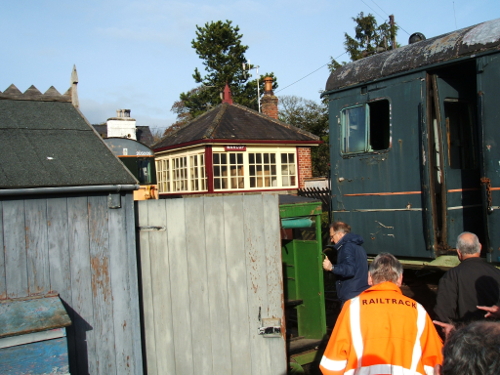
Sunday November 11th. 2012; Visit to Eden Valley Railway.
November 11th saw a dozen members enjoy a bright autumn day at the Eden Valley Railway Trust's site at Warcop. David Heywood and his colleagues from the Trust gave us a warm welcome. David started the visit with a brief history of the station and especially its more recent history under both BR and the Trust.
The EVR Trust moved onto the Warcop site in 1999 and ran its first Brake Van rides (using Motor Luggage Vans as propulsion) on the 2003 August Bank Holiday weekend. Scheduled trains now run in the summer months along the section from Warcop station north towards the limit of their property near Sandford Mire; the remainder of the trackbed to the junction with Network Rail is the property of Sustrans.
Whilst at Warcop members were given the opportunity not only to examine most of the stock in the yards, but also to walk as far as the southern limit of the line. Back at the passenger station we enjoyed a ride up to Sandford Mire before returning to Warcop.
Thumper, 4-BEP and Wickham Trolley in front of the Warcop signal box on the Eden valley Railway.
Saturday June 16th. 2012; Visit to Carnforth Station and round its Railway.
The group met at the station on platform 2 under the clock at 11.15 hours, for a walk led by two guides Philip Grosse and Clive Holden.
The walk round Carnforth visited the sites of the LNWR and MR sheds and staff housing. It passed through the town to East Junction, seeing the remnants of the Carnforth Iron Works and the LMS staff wartime facilities for stranded train crews.
Opportunity was taken to examine the derelict original 1880 Furness Railway's Station Junction signal box, which had obviously been used as an office before becoming a pigeon roost.
The party returned to the station to have some lunch in the Brief Encounter Buffet, viewing of the Heritage Centre and examining the unusual clock mechanism and learning of the history of its restoration. Torrential rain during this time ensured that some members had to paddle to reach their homeward train.
Sunday 18th.March 2012; Visit to the Eastern section of Lord Carlisle's Railway.
Walkers and one dog assembled in glorious sunshine to walk the abandoned mineral line from Tindale to Lambley. Despite being windswept moorland, there were railway relics wherever you looked, and bumps and dips in the ground often turned out to be spoil heaps and pits.
The walk was led by Graham Brooks, a local vet and expert on the Lord Carlisle system. As well as serving the pits, some of which seemed to have been opened more in optimism than realistic expectation, the line also supported the Co-operatives, which seemed to be the only shop in town in most of the communities, and had their own warehouses and rail sidings, the warehouses and shops themselves still remaining today.
There was also an interesting social observation that there were large non-conformist chapels built, and a small corrugated iron Anglican church to minister to the souls who toiled in this landscape. These again, still stand today, but often serving different purposes.
The system formed an end-on connection to the Newcastle & Carlisle Railway at Lambley Colliery. Trains arriving via a reversal at Lambley station having crossed the Lambley viaduct. The line continued on past Coanwood colliery site and station to the present day car park where the walk ended. This was a fascinating trip, through an area rich in industrial heritage, and well worth exploring.
Sunday 13th.November 2011; Visit to Ravenglass & Eskdale railway.
Fifteen members gathered under blue skies and sun for a guided exploration of the R&ER, led by Peter van Zeller. The visit included the sheds, workshops and an explanation of the Railway's radio signalling system, based on the American train order system. The party then journeyed behind River Irt to Dalegarth (with several members having footplate rides) for lunch at 'Fell Bites'.
It was disclosed that Dalegarth may once have been called 'Woolpack Road'. A trip down the 'tramway with footpath rights' to the cottages led to a walk along the old 3-foot line, which is still officially a railway, to Boot. The remains were still clearly visible, even though no trains had run in nearly a century. The mining inclines and relics were studies as were the legal intricacies surrounding the line. You would struggle to make up such a story.
The trip continued along the old line to the mines at St Catherine's, before returning to catch the Irt back to Murthwaite. The old crushing plant site was examined and the site of the Big Points pointed out before catching 'Douglas Ferreira' back to Ravenglass to complete a very enjoyable trip. Even those who knew the line well learnt something, such is the fascinating and convoluted history of the line.
Saturday 18th.June 2011; Bolton Fell Peat railway and Brampton Town.
Fifteen of us braved the forecast wet weather (what else for a CRA field trip?) to visit the Bolton Fell Peat Railway. The line and site are being wound down, so this was a chance to observe and record what is a disappearing part of Cumbria's railway history, albeit one that is younger than a number of our members!
The line is very much a 'flung down tramway' style of operation, being relocated as needed to access different parts of the peat moss. The 7 mile line was a fascinating enterprise, and we hope to collate our learnings and produce an article in the journal about the railway itself as opposed to the normal field trip report.
In the afternoon, we visited Brampton Town Station, finding an extant wall of the original coal staithes (inside someone's workshop), the platform and ticket office. This was followed by a walk along the old trackbed to Brampton Junction station where the old bay platform is still clearly visible. Time and weather precluded visiting Kirkhouse and Hallbankgate; these will wait for another day.
Sunday 20th.March 2011; Whitehaven, Cleator & Egremont Railway.
The curse of the CRA field trip struck again, as rain and low cloud marked saw twenty-five members of the Association walking between the sites of Moor Row and Rowrah stations along the track bed of the Whitehaven, Cleator & Egremont Railway, led by Philip Ashforth, a researcher into West Cumbrian Iron Ore mining.
This was a fascinating walk which revealed a wealth of railway and industrial history unknown even to those of us familiar with that line. The walk included diversions to see interesting mining relics such as the black ship - a concrete 'canal' built to take water away from mining areas. Difficulties in determining which was the track, which the route built to circumvent subsidence and which a siding led some to suggest that the CRA ought to consider helping with the provision of informative signs along the route. There was little to tell the unaware of the vast railway history in this area.
It was not unusual on this walk to find a 3 track overbridge bridge emerging from the undergrowth at one point - on a very minor branch line to a mine. Few would be aware that it was there. A very interesting walk, and well worth braving the mist for. See Journal vol. 6 no. 6 for a more comprehensive and illustrated account.
Sunday 7th.November 2010; Kirkby Stephen East and Viaduct Trail.
A large group of members assembled in the car park in glorius sunshine to be told by the Stainmore Railway Co. Chairman, Mike Thompson, a bit about the history and future plans for the site. It was considerably warmer outside than in the train sheds!
Members were then given free rein to explore the site walking up to the preent limit of track by bridge three and exploring inside the train sheds and museum. Lunch was taken in the wonderful surroundings of their Gresley Buffet Car! The hoped for Brake van rides did not happen but progress is such that need to have them sorted by next year when they take delivery of a steam locomotive from the National Railway Museum on a rolling five year loan agreement. August Bank Holiday 2011 looks like a weekend to put in ones diary!
After lunch a walk was taken along the former trackbed from KSE to the site of Halcrow quarry. This included crossing two viaducts now in the care of the Northern viaduct trust who have had them restored for use as a foot and cycle path.
Saturday 19th.June 2010; A re-creation of a Furness Railway Middle Circular Tour...
...in the Spirit of Alfred Aslett to Mark the 150th Anniversary of the Inauguration of the Steam Yacht Gondola on Coniston Water.
This involved over 70 people meeting at Haverthwaite by 10.30 for the 10.40 Train to Lakeside. We then boarded a steamer for the journey along Windermere to Ambleside. Vintage road transport in the form of two buses from the Preston, Ribble, Preservation Group, conveyed passengers to Coniston where time was available for sight-seeing and also a visit to late Major Hext's minature railway before we boarded Gondola for an evening cruise to Lake Bank Pier.
On return to Coniston Pier, road transport was on hand to return passengers to Haverthwaite, arriving at 20.30 hrs. The chances of it being created at a later date are very remote.
Sunday 21st.March 2010
A goodly number of members assembled for a Guided walk around Barrow-in-Furness, including parts of the docks.
It was surprising to see parts of the original station still standing yet more recent ones had vanished! Even since the pre-visit for planning the walk had taken place lots of changes had occurred including gates and new tarmac footpaths.
Sunday 15th.November 2009; Millom visit.
Members met at Millom Network Centre in the grounds of Millom School, Salthouse Road, Millom LA18 5AB at 10.30 am. Bill Myers showed his collection of photos of Millom industrial locos and the ironworks. A short walk to the former ironworks site then followed.
In the afternoon we visited the club room and layouts of the Millom Railway & Scale Modellers. Lots of discussion took place about the photographs shown and various items pointed out during the walk. The visit to see a 2mm scale model of Millom station was even more interesting. As a result we now have a copy of an official railway plan to add to our archive collection as well as much more information. A book dedicated to the area may even by forthcoming in the future.
Saturday 20th.June 2009; Threlkeld.
Members visited Threlkeld Quarry for steam operation on the former Bramcrag quarry tramway, and some also went on an underground tour of a new mine! Well it isn't a real mine but gives an example of what one would have been like.
One group went for a walk along the former trackbed to Bramcrag quarry while the remainder enjoyed a ride behind the steam locomotive 'Sir Tom' which had been steamed especially for our visit. Lunch was taken in the snack room and when the walkers returned another trip behind 'Sir Tom'. was taken. Most of those present then walked the CKPR trackbed into Keswick and returned by bus. Following a request from members this was on the SATURDAY and not Sunday.
Sunday 15th.March 2009; Visits around Carlisle.
Following on from our meeting the previous day we went out and about to look at both Carlisle Railway Station as well as the West Coast Signalling Power Box, having met at Club 35, Lowther Street, for coffee and introductions.
We started with a guided walk around the station, led by our speaker from the previous day Denis Perriam. A return to Club 35 for a buffet lunch,then in the afternoon we went down to the power box. We were restricted as to how many could go in the box at one time but we managed!
Virgin Trains gave us permission to go down into the basements, which was a first for many members. Also arranged in the afternoon was a visit to the model railway clubs who have clubrooms in the station, Carlisle 'O' Gauge group and Border Railway Society. Members of the Caledonian Railways Association joined us on this day.
November 2008.
A group of members assembled at Burneside Railway station. The aim of the day was to look around at the remains of the James Cropper rail connections to there factories. This included walking along the route of the narrow gauge line that ran up the valley from Burneside.
Various remains were discovered and a couple of people who had been around when the line was in operation were met who imparted valuable information. The walkers finally finished at Stavely for a bite to eat at Wilf's cafe and/or a drink in the the beer hall of Hawkshead Brewery.
A few then made the short journey back by train, considerably increasing the normal number of passengers from there, much to the surprise of the TTI.
June 2008.
A large group of members ventured onto the area of the old Brampton Fell Railway. Starting at the RSPB reserve at Hallbankgate, a circular route was followed, walking the old railway track to Forest Head, inspecting large lime kilns and discussing different railway systems.
At Howgill, the terminus of the original horse tramway was inspected and rail developments including reinstatement for Gairs colliery were discussed
On to Tindale to see the foot of Bishop Hill incline and lime kilns, Tindale spelter site, and large embankment. Returning from Tindale along the trackbed we passed Roachburn colliery sidings, two smaller collieries and Clowsgill Quarry.
The walk was led by Graham Brooks, and although the weather was not very kind, everybody learned something new.
March 2008.
The route of the Rowrah and Kelton Fell Mineral Railway was followed by a large group who had a very interesting and informative walk lead by Dai Powell of the Cumbria Historical Industrial Society.
©Cumbrian Railways Association - Registered Charity Number 1025436.
View Copyright and Terms of Use
34
Website by HomespunCreations